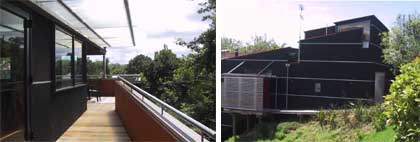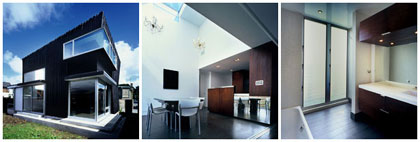Recent Infill Housing Examples
Review of two small Auckland houses on infill sites.
Holt House by Mitchell & Stout Architects
Moon House by Andrew Lister Architect
Published in Architecture New Zealand, May/June 2004.
It’s a common enough occurrence: young clients turn up bright-eyed and bushy-tailed with an infill site and having found out from the builder brother of a friend that building costs are about $1200 a square metre. You carefully point out – while vigilantly watching for telltale signs that their commitment to you is flagging – that the market is currently overheated, it is difficult to find builders, and that even when you do they aren’t being terribly competitive in their pricing. Yes, of course, you are capable of building their dreams, but you have to have the resources available to really do your best… and have they considered staging the project?
In a recent article in the Listener (“Home Truths”, January 15, 2005) Douglas Lloyd Jenkins posited that in New Zealand using architects has become a sport for the wealthy. He may be right, but is there any hope for those not-so-flush who have a site and access to a $300 000 mortgage?

Holt House
When asked to explain the origins of this design for a Grey Lynn house David Mitchell brandishes an A4 document with barely concealed glee. It is a report, compiled by council planners during a prolonged resource consent process, that helpfully gathers together photos of houses in the local area and categorises them under such forbidding headings as “Examples of modern homes with design features that complement surrounding character homes”, and, for the more aesthetically upsetting instances, “Examples of modern homes without any design features that relate to the surrounding character homes” (sic). Two of the three residences in this latter guilty group are Felicity Wallace’s townhouses (1997) and Noel Lane’s house (1990) for Amanda Gibbs, both in Cox’s Bay and both award winners in their day, but evidently provocative additions to their streetscapes.
Mitchell and Stout Architects clearly decided that in the case of the Holt House they would rather be members of the delinquent club. Certainly, the street elevation – a black box with a double garage door but not a lot else – belongs more to the f… off school of facade composition than the new-urbanist. David Mitchell’s partial explanation is that they (the design is a collaboration with his son Julian) worked at achieving the “ordinary” for a client and friend who is single and “completely unpretentious”. The notion of ordinariness is an interesting one to hang a design off. Presumably it relates more to modesty and simplicity than any desire to create the normal or usual. Mitchell also notes their desire not to get caught in the “current architectural fascination with surface”.
The general massing of the house follows the narrow building envelope down the gully in a pretty straightforward way, with sheltering roofs hanging from the long sides over the entry on the west and the outdoor deck to the east. The entry opens directly into a main living space that is comfortably loose-fitting and open. Ordinariness in interiors apparently comes with gib walls, overlay timber flooring, exposed douglas fir rafters and unfinished fibre cement sheet ceilings. The deck that is integrated into the corner of living and dining contributes ample of that quality beloved of makeover programmes: indoor/outdoor flow. The ease and generosity of space on this level doesn’t quite make it to the other parts of the house, where small rooms and bathrooms are a bit too ordinary for my taste.
The exposed timber beams and rafters candidly communicate their roles in the structural system and add to the impression of the house being unpretentious, although it is an expression of humbleness since we all know that there’s nothing cheaper than gib. The kitchen ceiling (the most structurally expressive part of the house) could have been omitted to allow more loft-like (and ordinary) space and perhaps a more interesting relationship between the living area and the owner’s upstairs deck. Similarly, the richness of the cabinetry, veneered with rewarewa, seems discordant against the other, more robust material choices. On the other hand, the flathead nails in the ceiling suffer from being too rough and ready.

Moon House (photos by Becky Nunes)
If you attended the NZIA local awards evening in Auckland late last year you may remember Graeme Moon as the client who gave the most enthusiastic acceptance speech. He and his partner Angela Sheehy are young Auckland professionals who say they got into the house building game by accident. They were simply trying to find a house to buy in a certain part of Point Chevalier when an empty section came up for sale. “How hard can it be?” they wondered, as they bought the land …
The freshly minted rear site that they purchased is a fairly tight fit around the 150 m2 house that Andrew Lister has designed for them, but its dead flatness would have helped with the budget. The meticulously blank elevation that greets visitors has already proved a captivating image for an Australian publication. Exhibiting the “obsession with surface” that Mitchell and Stout were keen to avoid, Lister’s design is a dark and textured piece of origami that is all the more impressive in that its brazenly windowless surfaces face northwest. The composition could have had even stronger abstraction if the white forms of garage and entry were combined into one, without stepping the entry roof.
Even more than in the Holt House, things are compact here. There’s 50m2 less to work with, but the impression is that the architect has skilfully planned and detailed to get the most out of the compressed area and budget. Skylights above the stair, ensuite and dining room, the sunken bath and open shower in the guest bathroom, mirrored wall of the kitchen, pushed-out window in the main bedroom and full-height corner openings in the downstairs rooms all work hard to make individual spaces roomier and more light-filled.
The danger of top-lighting rooms in the Auckland climate is heat gain and this contributed to a sense of closeness when visiting at the end of a sunny summer afternoon. Another contributing factor was that, as yet, no landscaping has been completed and no decks built; therefore movement out into the garden is interrupted.
The material palette is limited in most rooms to white-painted gib, but the ground floor pivots around the kitchen in such a way that the warm dark plywood of the kitchen cabinetry contributes its influence to the entry hall, dining and living rooms.
Conclusions
So what can people expect when they decide to work with an architect? At the most prosaic level, the owners of the Moon House owners received 150 m2 for $330,000 plus GST, including all fees, appliances and fittings, while the Holt House’s 200 m2 came in at $362,000 plus GST for the building contract without fees or kitchen or overlay flooring. A construction cost of more than $2,000 per square metre may well be shocking for potential home builders, but it illustrates the effect of the busy industry over the last few years.
On a more individual level, patrons of architects receive a home as a built response to personalities and aspirations (the clients’ personalities and aspirations, that is). Interestingly, on both the Holt and Moon projects the architects have chosen to build black boxes with their backs turned to neighbours and the street. Is this an expression of particular circumstances? Or is it more an articulation of the times and a desire to create private environments separate from the public domain? Do wearers of large dark sunglasses do it to stimulate feelings of privacy or superiority? (Okay, or to stop squinting?)
The Holt House sits on a narrow and steep site which was subsequently revealed to be mostly insubstantial fill. This compelled the design to step down the hill towards the north, on deep piles, making the house more expensive but also providing it with a generous outlook over the back gardens of Grey Lynn. The Moon House, by contrast, is its own little world on its flat rear site encircled by close neighbours. The sensation is currently quite interior but this should change as landscaping is completed and movement between inside and out becomes easier.
A week after visiting both houses the casualness of the main floor of the Holt House grows on you while the initial buzz of the Moon House wanes. The ordinariness that was the stated objective of the Mitchells may have been a red herring, but there is certainly a sense of relaxation and ease of movement that would make this my pick to live in (if I didn’t need to go downstairs). The suspicion is that this has more to do with the extra space available, the more unstructured plan shape and the relationship between interior and the deck than any material or detailing moves.
There is no doubt, however, which is the more beautiful house for the passer-by. The Holt House presents a tough face while over at the Moons’ there are many gorgeous bits and Lister has given his understandably enthusiastic clients a deftly precise composition of space and detail. And so would anyone be game to guess which house would sell for the higher price? Both are the product of very skilful architects beginning with subtly different sets of parameters and quickly diverging down different paths of inquiry.
And what of Douglas Lloyd Jenkins’ claim that residential architects are just trick-providers for rich people? Most architects just want to do decent designs and feed their kids, and if doing small houses will pay the bills then great. We gag over the builder brick ‘n tiles springing up in the suburbs but we haven’t yet worked out the means of production that would allow better designs to put them out of business. Who knows if more architects here will follow their Australian cousins into prefab work, but the market is a great decider of what works (in a larger sense) for people, and frankly architects working as consultant professionals don’t have what it takes to compete at the affordable end of the residential market. So (in Auckland, at least) there is a natural drift up the residential food chain because, if Joe Average can’t build a new architect-designed house for a couple of hundred thou, then he won’t use an architect.
Aaron Sills
